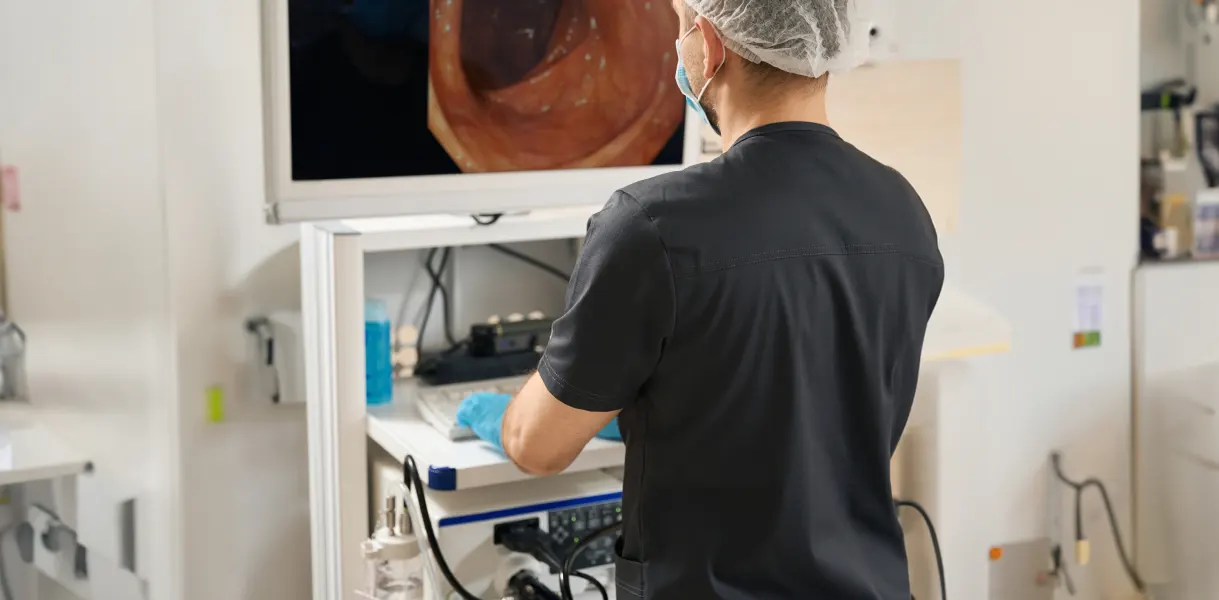Endoscopic Ultrasound (EUS) is a sophisticated procedure that combines endoscopy and ultrasound technology to provide detailed images and information about the digestive tract, and sometimes areas around it. Here’s a breakdown of how EUS works and why it might be recommended:
What is EUS?
EUS involves using a special endoscope equipped with an ultrasound device at its tip. This setup allows your gastroenterologist to get closer to the organs of interest than standard ultrasound techniques, which use probes on the skin surface. By inserting the endoscope into the gastrointestinal tract, high-quality images from inside the body can be obtained.



How is EUS performed?
Procedure: The endoscope is typically inserted through the mouth and can be directed down into the stomach and duodenum, or less commonly, into the colon for lower gastrointestinal tract examination.
Duration: The procedure generally lasts between 30 to 60 minutes, depending on the complexity and what areas need to be examined. If a biopsy or a cyst is drained during EUS, the procedure may take longer. Your doctor may instruct you to arrive at the treatment facility an hour or so before the EUS is scheduled so that preparation for the procedure can begin. This can extend the total time of the procedure.
Preparation and Follow-up: You might be asked to fast for a certain period before the procedure. Sedation is usually provided to help you relax and minimise discomfort. After the procedure, your doctor will discuss any findings and specific care instructions, especially if a biopsy is taken.
What are the Indications for EUS?
Cancer Evaluation: EUS is invaluable in staging cancers of the gastrointestinal tract, such as esophageal, gastric, pancreatic, and rectal cancers, because it helps determine how deep a tumor has penetrated and if it has spread to nearby lymph nodes or organs.
Pancreatic Abnormalities: It’s particularly useful for diagnosing issues in the pancreas, including tumors or cysts, that might not be visible on other imaging tests.
GI Tract Lesions: EUS can identify and assess lesions within the walls of the GI tract, helping distinguish between benign and malignant growths.
Pain Management in Pancreatic Cancer: For therapeutic purposes, EUS can be used to administer
What are the possible complications of EUS?
Endoscopic Ultrasound (EUS) is widely regarded as a relatively safe procedure, nevertheless, like all medical procedures, EUS carries potential risks and complications, though these are infrequent. Understanding these possible complications is important for patients undergoing EUS, and they should be discussed thoroughly by your gastroenterologist prior to the procedure. Here’s an overview of the complications that can occasionally arise from EUS:
Possible Complications of EUS
- Infection: Although rare, there is a risk of infection resulting from the introduction of the endoscope into the body. This risk is minimised by the stringent sterilisation protocols followed for the equipment used.
- Perforation: One of the more serious but rare complications is the perforation, or tearing, of the gastrointestinal tract wall, which can occur due to the movement of the endoscope or the instruments used during the procedure. This may require surgical intervention to repair.
- Bleeding: If a biopsy is performed during the EUS, there is a small risk of bleeding at the site of tissue removal. This is typically minor and often stops on its own or can be controlled by the endoscopist during the procedure.
- Pancreatitis: Inflammation of the pancreas, known as pancreatitis, can occur, particularly when EUS is used to investigate pancreatic lesions. This complication is seen in approximately 1% of these cases. Symptoms include severe abdominal pain and require prompt medical treatment.
- Vein Irritation: The vein used for the administration of sedative medications might become irritated, potentially resulting in a tender lump that can persist for several weeks. This is generally managed conservatively with warm compresses to ease discomfort.
- Sedative Reactions: Although sedatives are used to make the procedure more comfortable, they can occasionally cause adverse reactions. Patients with pre-existing heart or lung conditions may also experience exacerbations of these conditions as a reaction to sedatives.
What to Do Post-Procedure
When the procedure is finished, you will be in the recovery room until the sedative starts to wear off. Your doctor will discuss the initial findings with you, but you may need to wait a few days for the results of a biopsy if one was performed.
After you talk to the doctor, your care partner can drive you home, where you should rest for the remainder of the day. As you recover from EUS, you might experience:
A sore throat or tongue, or swollen lips if the endoscope was inserted through your mouth
- Nausea or vomiting
- Excessive intestinal gas
- Stomach bloating or cramping
After undergoing EUS, it’s crucial to monitor your condition for any signs of complications. Here are some symptoms that should prompt immediate contact with your doctor:
- Fever: Could indicate an infection.
- Significant Pain: Particularly important if the pain increases or is persistent, as it could signify pancreatitis or perforation.
- Bleeding: Any signs of bleeding from the mouth or rectum should be reported immediately.
Contact Us To Find Out More About Endoscopic Ultrasounds
While the potential complications associated with EUS can be concerning, they are relatively rare, especially under the care of experienced gastroenterologists. Proper pre-procedure discussion, including a review of the patient’s medical history and any existing conditions, can further mitigate risks. By being aware of the possible risks and the symptoms to watch for post-procedure, patients can be better prepared to undergo EUS with informed confidence.
